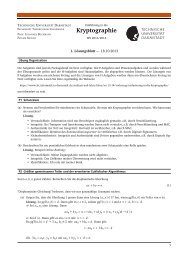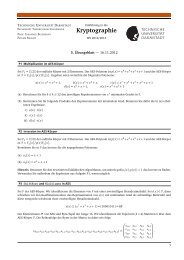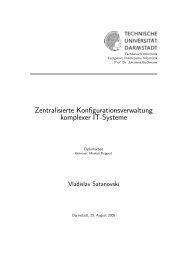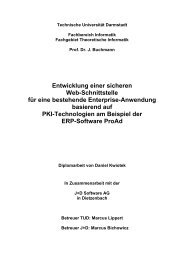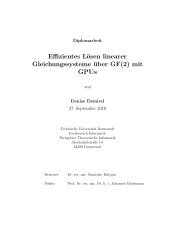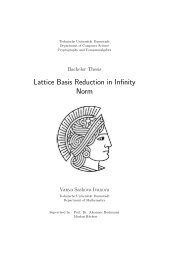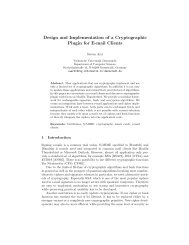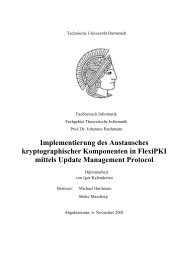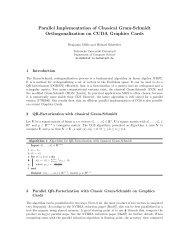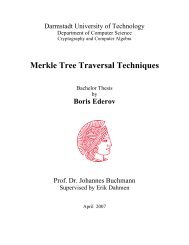An efficient mobile PACE implementation - CDC
An efficient mobile PACE implementation - CDC
An efficient mobile PACE implementation - CDC
You also want an ePaper? Increase the reach of your titles
YUMPU automatically turns print PDFs into web optimized ePapers that Google loves.
ABSTRACT<br />
<strong>An</strong> <strong>efficient</strong> <strong>mobile</strong> <strong>PACE</strong> <strong>implementation</strong><br />
Alex Wiesmaier,<br />
Moritz Horsch<br />
TU Darmstadt<br />
Hochschulstraße 10<br />
64289 Darmstadt, Germany<br />
{wiesmaier|horsch}<br />
@cdc.informatik.tudarmstadt.de<br />
Detlef Hühnlein<br />
ecsec GmbH<br />
Sudetenstrasse 16<br />
96247 Michelau, Germany<br />
detlef.huehnlein@ecsec.de<br />
Many future electronic identity cards will be equipped with a contact-less<br />
interface. <strong>An</strong>alysts expect that a significant proportion of<br />
future <strong>mobile</strong> phones support Near Field Communication (NFC)<br />
technology. Thus, it is a reasonable approach to use the cell phone<br />
as <strong>mobile</strong> smart card terminal, which in particular supports the<br />
Password Authenticated Connection Establishment (<strong>PACE</strong>) protocol<br />
to ensure user consent and to protect the wireless interface between<br />
the <strong>mobile</strong> phone and the smart card. While there are <strong>efficient</strong><br />
<strong>PACE</strong> <strong>implementation</strong>s for smart cards, there does not seem<br />
to be an <strong>efficient</strong> and platform independent solution for <strong>mobile</strong> terminals.<br />
Therefore we provide a new <strong>implementation</strong> using the Java<br />
Micro Edition (Java ME), which is supported by almost all modern<br />
<strong>mobile</strong> phones. However, the benchmarks of our first, straightforward<br />
<strong>PACE</strong> <strong>implementation</strong> on an NFC-enabled <strong>mobile</strong> phone have<br />
shown that improvement is needed. In order to reach a user friendly<br />
performance we implemented an optimized version, which, as of<br />
now, is restricted to optimizations which can be realized using features<br />
of existing Java ME libraries.<br />
In the work at hand we present a review of the relevant algorithms<br />
and provide benchmarks of the corresponding arithmetic<br />
functions in different Java ME libraries. We discuss the different<br />
optimization approaches, introduce our optimized <strong>PACE</strong> <strong>implementation</strong>,<br />
and provide timings for a desktop PC and a <strong>mobile</strong><br />
phone in comparison to the straightforward version. Finally, we<br />
investigate potential side channel attacks on the optimized <strong>implementation</strong>.<br />
Categories and Subject Descriptors<br />
K.6.5 [Management of Computing and Information Systems]:<br />
Security and Protection—authentication, unauthorized access<br />
Permission to make digital or hard copies of all or part of this work for<br />
personal or classroom use is granted without fee provided that copies are<br />
not made or distributed for profit or commercial advantage and that copies<br />
bear this notice and the full citation on the first page. To copy otherwise, to<br />
republish, to post on servers or to redistribute to lists, requires prior specific<br />
permission and/or a fee.<br />
ASIACCS ’11, March 22–24, 2011, Hong Kong, China.<br />
Copyright 2011 ACM 978-1-4503-0564-8/11/03 ...$10.00.<br />
Falko Strenzke<br />
Flexsecure GmbH<br />
Industriestr. 12<br />
64297 Darmstadt, Germany<br />
strenzke@flexsecure.de<br />
Johannes Braun,<br />
Franziskus Kiefer<br />
TU Darmstadt<br />
Hochschulstraße 10<br />
64289 Darmstadt, Germany<br />
{jbraun|kiefer}<br />
@cdc.informatik.tudarmstadt.de<br />
General Terms<br />
Johannes Buchmann<br />
CASED<br />
Mornewegstraße 32<br />
64293 Darmstadt, Germany<br />
buchmann@cased.de<br />
Algorithms, Design, Performance, Security<br />
Keywords<br />
Extended Access Control (EAC), Elliptic Curve Cryptography<br />
(ECC), European Citizen Card, Efficient Exponentiation, Electronic<br />
Identities (eID), Mobile Devices, Near Field Communication<br />
(NFC), Password Authenticated Connection Establishment<br />
(<strong>PACE</strong>), Java Platform Micro Edition (Java ME)<br />
1. INTRODUCTION<br />
Many countries around the world have engaged in the deployment<br />
of electronic identity (eID) cards [2, 9, 29]. The European<br />
Committee for Standardization (Comité Européen de Normalisation,<br />
CEN) is currently developing the technical standard series<br />
CEN prTS 15480 [7], which defines services, command sets, application<br />
interfaces and profiles for European Citizen Cards. [7,<br />
Part 4, <strong>An</strong>nex A] specifies card application templates and there<br />
is a profile, which specifies an “eID application with mandatory<br />
ICAO functionality and conditional digital signature functionality”.<br />
This profile will be implemented for example by the forthcoming<br />
German eID card [10] and may serve as blueprint for other citizen<br />
cards, which also provide machine readable travel document<br />
functionality as specified by the International Civil Aviation Organization<br />
(ICAO) [15–17]. Such citizen cards will in particular<br />
provide a contact-less interface according to [19] and support version<br />
2 of the Extended Access Control (EAC) protocol according<br />
to [11]. Because analysts expect [23] that a significant proportion<br />
of future <strong>mobile</strong> phones will be equipped with Near Field Communication<br />
(NFC) technology [21, 22], it is worth to investigate<br />
whether NFC-enabled phones may serve as smart card terminals<br />
for <strong>mobile</strong> European Citizen Card applications.<br />
The EAC protocol may in particular be used together with the<br />
Password Authenticated Connection Establishment (<strong>PACE</strong>) [11,<br />
Section 4.2] protocol. <strong>PACE</strong> ensures user consent and protects the<br />
wireless channel between the <strong>mobile</strong> phone and the smart card. It<br />
is specified in a way that allows implementing it using different<br />
cryptographic primitives. The work at hand focuses on <strong>PACE</strong> realized<br />
using Elliptic Curve Cryptography (ECC), especially on the<br />
version used in the forthcoming German eID card.
There are already very <strong>efficient</strong> hardware specific <strong>PACE</strong> <strong>implementation</strong>s<br />
for low power devices written in C and Assembler [34].<br />
In order to support a maximum of <strong>mobile</strong> devices without depending<br />
on special hardware or operating systems we provide a Java<br />
Micro Edition (Java ME) <strong>implementation</strong> of <strong>PACE</strong>. But while our<br />
reference Java <strong>implementation</strong> of <strong>PACE</strong>, which is straightforward<br />
and contains no optimizations, performs well on typical desktop<br />
systems (cf. Table 9), the <strong>efficient</strong> <strong>implementation</strong> on a <strong>mobile</strong><br />
phone turns out to be a challenging task. Various optimizations are<br />
required in order to come up with a user friendly performance.<br />
The optimizations investigated here are restricted to those which<br />
can be realized using features existing libraries for Java ME provide.<br />
Adaptations of algorithms to the special needs of the <strong>PACE</strong><br />
protocol and their <strong>implementation</strong> are subject to ongoing work.<br />
The paper is structured as follows. Section 2 provides the necessary<br />
background on the <strong>PACE</strong> protocol. Section 3 gives an<br />
overview of <strong>efficient</strong> elliptic curve (EC) point multiplication algorithms<br />
including the number of involved point additions and doublings.<br />
Section 4 discusses different approaches to optimize the<br />
<strong>PACE</strong> <strong>implementation</strong>. Section 5 provides benchmarks for large<br />
number arithmetic in different Java ME libraries. It presents the<br />
main aspects of the optimized <strong>implementation</strong> and compares the<br />
resulting timings to those of the reference <strong>implementation</strong>. This<br />
is done separately for different Cryptographic Service Providers<br />
(CSP) as well as on desktop PC and cell phone. Section 6 addresses<br />
potential side channel vulnerabilities of the optimized <strong>implementation</strong>.<br />
Section 7 gives an outlook on future work and improvements<br />
currently restricted by hard- or software limitations. Section 8 summarizes<br />
the presented work and concludes the paper.<br />
2. BACKGROUND ON <strong>PACE</strong><br />
<strong>PACE</strong> was developed by the German Federal Office for Information<br />
Security (Bundesamt für Sicherheit in der Informationstechnik,<br />
BSI) and is designed to be free of patents. Security analyses<br />
of the <strong>PACE</strong> protocol can be found in [3, 34]. From this point on<br />
we use the terms and notation introduced in [11]. There, the term<br />
for a contact-less smart card is Proximity Integrated Circuit Card<br />
(PICC) and the contact-less smart card terminal is called Proximity<br />
Coupling Device (PCD).<br />
Besides other things, <strong>PACE</strong> establishes a shared session key between<br />
the PICC and the PCD using the well known Diffie-Hellman<br />
(DH) key agreement protocol [8]. For elliptic curves this works<br />
as follows: Two parties A and B want to agree on a shared key.<br />
Each party selects a secret scalar dA and dB respectively. Using a<br />
public EC point Q then A computes QA = dA ∗ Q and B computes<br />
QB = dB ∗ Q. After exchanging the results, A computes<br />
QAB = dA ∗ QB and B computes QAB = dB ∗ QA. The common<br />
key is the x-coordinate of QAB.<br />
As the DH key agreement does not support authentication of the<br />
communication partners it is vulnerable to man-in-the-middle attacks.<br />
In order to prevent this and to ensure user consent, <strong>PACE</strong><br />
uses a password-based protocol (see [4, Section 7] for similar protocols<br />
of this type) to protect the wireless communication interface<br />
between the PCD and the PICC before the PICC is accessed. In the<br />
most common scenario the password π is a Personal Identification<br />
Number (PIN), which is permanently stored in the PICC and is entered<br />
into the PCD by the user. As the password is used during the<br />
calculation of the session key, entering a wrong password leads to<br />
different session keys on both sides which causes the connection<br />
establishment to fail.<br />
Figure 1 provides an overview of the steps of the <strong>PACE</strong> protocol.<br />
Before the protocol starts the PCD needs to read the domain parameters<br />
D from the PICC, which contain a common base point G and<br />
PICC PCD<br />
(a) Kπ = KDFπ(π) Kπ = KDFπ(π)<br />
(b) z = E(Kπ, s)<br />
z<br />
−→ s = D(Kπ, z)<br />
(c) Y = y · G<br />
X<br />
←−<br />
Y<br />
−→<br />
X = x · G<br />
(d) H = y · X H = x · Y<br />
(e) G ′ = s · G + H G ′ = s · G + H<br />
(f) � P KPICC = � SKPICC · G ′ � P KPCD ←− � P KPCD = � SKPCD · G ′<br />
�P KPICC −→<br />
(g) K = � SKPICC · � P KPCD<br />
K = � SKPCD · � P KPICC<br />
(h) KENC = KDFENC(K) KENC = KDFENC(K)<br />
(i) KMAC = KDFMAC(K) KMAC = KDFMAC(K)<br />
(j) TPICC =<br />
TPCD ←− TPCD =<br />
MAC(KMAC, � P KPCD)<br />
TPICC −→ MAC(KMAC, � P KPICC)<br />
Figure 1: <strong>PACE</strong> [11, Chapter 4.2]<br />
related ECC 1 parameters. The values x, y, � SKPCD and � SKPICC<br />
are uniformly chosen random numbers smaller than the order r of<br />
the elliptic curve.<br />
1. As depicted in step (b), the PICC chooses a nonce s uniformly<br />
at random and encrypts it using the encryption function<br />
E(key, ·) with the key Kπ derived in step (a) from the<br />
shared password π. The PCD decrypts the cipher text using<br />
the decryption function D(key, ·) and the same key Kπ to<br />
obtain the nonce s.<br />
2. Now both parties use s to generate new domain parameters<br />
D ′ = Map(D, s), which in particular contain a new common<br />
base point G ′ , which is used for the subsequent Diffie-<br />
Hellman key agreement. There are two options for the <strong>implementation</strong><br />
of the Map-function:<br />
• Generic Mapping<br />
The Generic Mapping [11, A.3.4.1] shown in steps (c) –<br />
(e) already has been supported in version 1 of the <strong>PACE</strong><br />
protocol. It is used by the German eID card, which is<br />
issued since November 2010. The new base point G ′<br />
is given as G ′ = s · G + H, where H is agreed upon<br />
by the two communication partners in an anonymous<br />
Diffie-Hellman key agreement.<br />
• Integrated Mapping<br />
In Integrated Mapping [18], which is only supported by<br />
version 2 of the <strong>PACE</strong> protocol, the new base point G ′<br />
is computed as G ′ = f(R(s � t)). Where t is chosen<br />
by the PCD and sent to the PICC, the pseudo-random<br />
function R is specified in [30] and the function f will<br />
most likely be based on [14] and [31]. Focusing on the<br />
German eID card which uses the Generic Mapping by<br />
now, we do not investigate the Integrated Mapping any<br />
further in the present work.<br />
3. As shown in steps (f) – (g), the PICC and the PCD respectively<br />
choose an ephemeral private key ( � SKPICC, � SKPCD)<br />
uniformly at random and perform a Diffie-Hellman key<br />
agreement based on G ′ . Both calculate a common secret<br />
point K.<br />
1 The specification of the <strong>PACE</strong> protocol in [11] also covers multiplicative<br />
groups over finite fields. Here we present our results for<br />
groups of points on elliptic curves. The results can be applied to<br />
multiplicative groups analogously.
algorithm parameter<br />
choices<br />
complexity #precomp.<br />
points<br />
left-to-right binary - 128A+256D -<br />
NAF - 85A + 256D -<br />
w-NAF w = 5 50A + 257D 7<br />
Sliding Window NAF w = 5 50A + 257D 10<br />
Table 1: Single point multiplication. The window parameters<br />
w are chosen to be optimal for the 256-bit curves. The given<br />
complexities in DBL (D) and ADD (A) operations are approximate.<br />
4. Steps (h) and (i) depict how the keys KENC for message encryption<br />
and KMAC for message authentication are derived<br />
from the common secret K using the key derivation functions<br />
KDFMAC and KDFENC [11].<br />
5. In step (j) both parties calculate a token (TPICC, TPCD) with<br />
the use of a MAC-function MAC(key, ·) which is a keyed<br />
hash computation using the key KMAC. These tokens are<br />
then used to perform a mutual key confirmation.<br />
3. OPTIMIZED POINT MULTIPLICATION<br />
Since the point multiplication is one of the biggest run-time consumers<br />
(cf. Section 5.1) in the <strong>PACE</strong> protocol, it promises the most<br />
potential for optimization. As an <strong>efficient</strong> point multiplication algorithm<br />
is the basis for an <strong>efficient</strong> <strong>implementation</strong>, we present the<br />
most common multiplication algorithms in this chapter.<br />
Our analysis of the point multiplication algorithms is based on<br />
[12] and focuses mainly on the complexity of given algorithms. As<br />
we do not change existing algorithms, we do not go into details<br />
how the given algorithms work.<br />
We denote the length of a scalar e by λ(e) as the number of<br />
binary digits. The cost of the group operation (addition) "+" is<br />
denoted by ADD (A). The cost of the scalar multiplication "·" is<br />
denoted by MULT (M), the cost of point doubling by DBL (D) and<br />
the cost of an interleaved multiplication (e1·P1+e2·P2) by PSUM.<br />
Note that in general MULT < PSUM < 2 MULT holds if the involved<br />
scalars and points have similar magnitudes respectively.<br />
The complexity evaluation and the notation of the algorithms in<br />
this section is according to [12] and for the ECC and <strong>PACE</strong> parameters<br />
employed by the upcoming German eID card. The relevant<br />
values are: λ(r) = λ(x) = 256; λ(s) = 128.<br />
3.1 Review of Basic Elliptic Curve Single<br />
Point Multiplication Techniques<br />
A variety of algorithms can be used to implement the single point<br />
multiplication on an elliptic curve. Compared to the most basic<br />
algorithm, the left-to-right binary method, the more sophisticated<br />
algorithms employ time-memory trade offs to speed up the computation.<br />
Table 1 gives an overview of the complexity of available<br />
algorithms. The formulas used to determine the complexity are<br />
shown in Table 2.<br />
The left-to-right binary method processes the bits of e from left<br />
to right one at a time. The internal intermediate result is initialized<br />
with the point at infinity. Each step doubles the current intermediate<br />
result and adds P each time a nonzero digit is processed. In the<br />
NAF methods e is transformed into the non-adjacent form (NAF)<br />
at first to reduce the density of nonzero digits to 1 /3 on average,<br />
therewith reducing the number of point additions. In the window<br />
methods multiples of P are precomputed and stored in additional<br />
memory. Then digits of e are scanned w at a time and the according<br />
algorithm complexity formula #precomp. points<br />
left-to-right binary<br />
NAF<br />
λ(e)<br />
2 A + λ(e)D -<br />
λ(e)<br />
3 A + λ(e)D -<br />
w-NAF (2 w−2 − 1 + λ(e)<br />
w+1 )A +<br />
(λ(e) + 1)D<br />
Sliding Window NAF ( 2w −(−1) w<br />
3 − 1 +<br />
λ(e)<br />
)A + (λ(e) + 1)D<br />
w+v(w)<br />
v(w) = 4 (−1)w<br />
3 −<br />
3·2w−2 2 w−2 − 1<br />
2 w −(−1) w<br />
3<br />
Table 2: Complexity evaluation formulas of unknown point<br />
multiplication algorithms [12]<br />
algorithm parameter<br />
choices<br />
complexity<br />
evaluation<br />
− 1<br />
#precomp.<br />
points<br />
left-to-right binary - 128A 256<br />
Windowing w = 4 77A 64<br />
Windowing NAF w = 5 71A 52<br />
Table 3: Fixed point multiplication with off-line precomputation<br />
in terms of expected point additions (A). The window parameters<br />
w are chosen to be optimal for the 256-bit curves.<br />
multiple of P is taken from the precomputed points and added.<br />
This further reduces the number of ADDs.<br />
The memory demands of the methods given in Table 1 are maximal<br />
for the Sliding Window NAF method. Here 10 additional<br />
points (and the two we also have in the left-to-right method) need to<br />
be stored. This sums up to 768 bytes (computed as 12·2·32). Note<br />
that the precomputations in Table 1 are dynamic precomputations,<br />
i.e. have to be done each time a scalar multiplication is conducted.<br />
If the multiplication involves a known point, off-line precomputations<br />
can be used to spare point doublings. 2 This can be done for<br />
all algorithms listed in Table 1. For each doubling operation to be<br />
spared in the non-window algorithms one additional point has to<br />
be stored in the device’s non-volatile memory (NVM). This sums<br />
up to 16.384 bytes to store all 256 additional points, which is not<br />
a problem on <strong>mobile</strong> phones. Note that these precomputed values<br />
can be considered public information and do not need to be kept<br />
secret. They need, however, integrity protection to avoid their manipulation.<br />
Table 3 gives the complexity of basic algorithms used with offline<br />
precomputation and the number of points to be stored in the<br />
NVM. Table 4 provides the complexity for the method based on the<br />
exponentiation algorithm due to Lim and Lee [26], including the<br />
total complexity if precomputation is done on-line. The formulas<br />
used for complexity evaluation are given in Table 5. The main idea<br />
of the method by Lim and Lee is to divide e into w bit strings of the<br />
2 In the future (some) precomputed points might be saved on the<br />
eID cards together with the base point, assumed that the space and<br />
bandwidth constraints will allow for that.
parameter w parameter v complexity<br />
evaluation<br />
complexity<br />
incl.<br />
precomp.<br />
#precomp.<br />
points<br />
4 1 64A + 63D 71A+255D 15<br />
4 2 64A + 31D 78A+255D 30<br />
5 1 51A + 50D 66A+255D 31<br />
5 2 51A + 25D 81A+255D 62<br />
Table 4: Fixed point multiplication with off-line precomputation<br />
according to Lim and Lee in terms of expected point additions<br />
(A) and doublings (D). The parameters w and v are<br />
chosen to obtain a good trade off between total complexity and<br />
complexity in the evaluation phase for 256-bit curves.<br />
algorithm complexity formula #precomp. points<br />
left-to-right binary<br />
Windowing (2 w +<br />
Windowing NAF ( 2w+1<br />
3<br />
λ(e)<br />
2 A λ(e)<br />
� �<br />
λ(e)<br />
w − 3)A<br />
+<br />
� �<br />
λ(e)+1<br />
w − 2)A<br />
Lim-Lee precomp:<br />
v(2 w−1 −1)A+(λ(e)− λ(e)<br />
wv )D<br />
main: λ(e) λ(e)<br />
w A + ( wv − 1)D<br />
� �<br />
λ(e)<br />
w<br />
� �<br />
λ(e)+1<br />
w<br />
(2 w − 1) · v<br />
Table 5: Complexity evaluation formulas of algorithms with<br />
off-line precomputation [12, 13]<br />
same length and to process them parallelly as different exponents<br />
comparable to multiple point multiplication with shorter exponents.<br />
<strong>An</strong> additional parameter v specifies how the different exponents are<br />
further partitioned and can also be seen as the number of lookup<br />
tables containing the precomputed points [12].<br />
In cases with no off-line precomputation the method by Lim and<br />
Lee can nearly compete with the window NAF methods. In cases<br />
with off-line precomputation the method by Lim and Lee performs<br />
significantly better than the window NAF methods.<br />
3.2 Review of Basic Elliptic Curve Multiple<br />
Point Multiplication Techniques<br />
There are several methods available [12] which evaluate product<br />
sums k ·P +l·Q much more <strong>efficient</strong> than carrying out the individual<br />
multiplications sequentially and add the results. The complexity<br />
and the number of stored points for different approaches can be<br />
seen in Table 6. The respective complexity formulas are given in<br />
Table 7.<br />
While in the first three algorithms addition and doubling operations<br />
are done simultaneously, interleaving only does the doubling<br />
simultaneously. In our case the latter has some advantages. Firstly,<br />
the precomputed points rely on the points P and Q only. This<br />
allows storing precomputed points for further use. Secondly, the<br />
method allows for exponents with different lengths. Both is useful<br />
in our <strong>PACE</strong> scenario.<br />
algorithm parameter choices complexity #precomp.<br />
points<br />
Simultaneous mult. point w = 2 128A + 256D 15<br />
Simultaneous slid. window w = 2 118A + 256D 12<br />
Simultaneous Joint Sparse<br />
Form (JSF)<br />
w-NAF Interleaving<br />
λ(e1) = λ(e2) = 256<br />
w-NAF Interleaving<br />
λ(e1) = 256, λ(e2) = 128<br />
− 129A + 255D 3<br />
w1 = w2 = 5 99A + 258D 16<br />
w1 = w2 = 5 78A + 258D 16<br />
Table 6: Multiple point multiplication in terms of expected<br />
point additions (A) and doublings (D). The window parameters<br />
w are chosen to be optimal for 256-bit curves.<br />
algorithm complexity formula stored points<br />
Simultaneous mult. point (3·2 2(w−1) −2 w−1 −1+<br />
2 2w−1<br />
2 2w<br />
� λ(e)<br />
w<br />
�<br />
− 1)A +<br />
(2 2(w−1) − 2 w−1 � �<br />
+<br />
λ(e)<br />
( w − 1)w)D<br />
Simultaneous slid. window (3·2 2(w−1) −2 w−1 −1+<br />
λ(e)<br />
w+1/3 )A + (22(w−1) −<br />
2 w−1 � �<br />
λ(e)<br />
+( w −1)w)D<br />
Simultaneous (JSF) (1+ λ(e)<br />
2 )A+(λ(e)−1)D 3<br />
w-NAF Interleaving ( �<br />
j (2wj −2 − 1) +<br />
� λ(ej )<br />
j wj +1 )A +<br />
(|j : wj > 2| +<br />
maxjλ(ej))D<br />
2 2w − 1<br />
2 2w − 2 2(w−1)<br />
�<br />
j (2w j −2 )<br />
Table 7: Complexity evaluation formulas of multiple point multiplication<br />
algorithms [12]<br />
4. OPTIMIZED <strong>PACE</strong><br />
In this section we discuss the most promising optimizations for a<br />
<strong>PACE</strong> <strong>implementation</strong> on cell phones. The stated amounts of ADD<br />
and DBL are derived from the findings from Section 3 and express<br />
the average case. The proposed optimizations all lead to very similar<br />
theoretic execution times. Which one is the best in practice<br />
seems to depend on the actual hardware and the respective environmental<br />
circumstances. As we have seen in Section 3, storage space<br />
for points is not an issue on modern <strong>mobile</strong> devices, and is therefore<br />
not considered here. Likewise the time to load these points can<br />
be assumed to be negligible.<br />
Following the <strong>PACE</strong> specification (cf. Figure 1) the PCD<br />
conducts the EC computations shown in Equations (1) to (5).<br />
Counting the PCD’s EC computations in this notation leads to a<br />
total of 1 ADD and 5 MULT.<br />
X = x · G (1)<br />
H = x · Y (2)<br />
G ′ = s · G + H (3)<br />
�P KPCD = � SKPCD · G ′<br />
(4)<br />
K = � SKPCD · � P KPICC (5)
4.1 Rearranging Equations<br />
When rearranging the equations we have to regard the following<br />
facts: X must be sent to the PICC in order to receive Y , and therefore<br />
it must be computed before H, G ′ , � P KPCD and K. � P KPCD<br />
must be sent to the PICC in order to receive � P KPICC and therefore<br />
it must be computed before K. In addition to Equation (3), G ′<br />
is needed in the last <strong>PACE</strong> step (j), because it is part of the input<br />
for the computation of TP CD. Thus, G ′ should be a result or be<br />
computable from the result without increasing the overall computational<br />
cost. We consider the following possibilities for merging<br />
the equations.<br />
α: Standard Interleaving.<br />
One possible optimization is to merge Equations (2) and (3) as<br />
shown in Equation (6) to compute G ′ using interleaved multiplication.<br />
X, � P KPCD, and K are computed as shown in Equations<br />
(1), (4), and (5). This leads to an overall computation cost of 3<br />
MULT and 1 PSUM. Using the best available algorithm and parameters,<br />
w-NAF Interleaving with w = 5, PSUM needs 78 ADD<br />
and 258 DBL (cf. Table 6). This is a vast improvement compared<br />
to 2 MULT evaluated as sequential single point w-NAF multiplications,<br />
which sum up to 78 ADD and 386 DBL (according to Table<br />
2). A possible shortcoming is that s, which is only half the length<br />
of x, is forced into a scalar multiplication of the dimension of the<br />
size of x.<br />
G ′ = s · G + x · Y (6)<br />
β: Short Scalar Interleaving.<br />
The shortcoming of the above Equation (6) regarding the interleaved<br />
multiplication with s and x may be countered using the following<br />
trick: We know that the size of s is half the size of x. We<br />
break the pair (x, Y ) into two pairs (x1, Y1) and (x2, Y2) as is<br />
done when using the Lim-Lee method. The scalars x1, x2, and s<br />
now have the same size and the pair (s, G) can be added as third<br />
summand to the pairs (x1, Y1) and (x2, Y2) resulting in a standard<br />
interleaved multiplication with three summands as shown in Equation<br />
(7). As with Equation (6), X, � P KPCD, and K are computed<br />
as shown in Equations (1), (4), and (5). This leads to an overall<br />
computation cost of 3 MULT and 1 PSUM where the scalars in the<br />
PSUM are half the size of those of the PSUM of Equation (6). Using<br />
w-NAF Interleaving with w = 5 PSUM needs 85 ADD and 131<br />
DBL according to Table 7 and additionally 128 DBL to prepare Y2.<br />
In total this is nearly the same as the PSUM costs resulting from<br />
Equation (6) and thus, is also a vast improvement compared to the<br />
not optimized version.<br />
G ′ = s · G + x1 · Y1 + x2 · Y2 (7)<br />
γ: Inversion.<br />
A third possibility is to merge Equations (2), (3), and (4) as<br />
shown in Equation (8) to compute � P KPCD using interleaved multiplication.<br />
G ′ then has to be computed by a scalar multiplication<br />
with an inverse as shown in Equation (9). X and K are computed<br />
as shown in Equations (1) and (5). This also leads to an overall<br />
computation cost of 3 MULT and 1 PSUM. w-NAF Interleaving<br />
leads to a cost of 99 ADD and 258 DBL (see Table 6). The necessary<br />
inversion and multiplications of scalars modulo the order r<br />
of the elliptic curve are neglectable in comparison to the operations<br />
on the points. A possible shortcoming is that the optimization potential<br />
of having an s of half the size of all other involved scalars is<br />
given away by multiplying it with a full size scalar. A possible ad-<br />
vantage of this approach is that the computation of G ′ , which is not<br />
needed again until the last step of <strong>PACE</strong> is reached, can be delayed<br />
until then.<br />
�P KPCD = ( � SKPCD · s) · G + ( � SKPCD · x) · Y (8)<br />
G ′ = ( � SK −1<br />
PCD mod r) · � P KPCD<br />
δ: Splitted Inversion.<br />
<strong>An</strong> also promising possibility to calculate � P KPCD is to reuse<br />
the precalculated points of G (see also Section 4.3) and evaluate<br />
Equation (10) with the Lim-Lee method. <strong>An</strong>other advantage of<br />
this method is the possibility to start the calculation of Equation<br />
(10) right after evaluating the first equation of the <strong>PACE</strong> algorithm<br />
(cf. Figure 1). Assumed the precomputed points or Lim-Lee multiplication<br />
are available, the evaluation of Equation (10) leads to 51<br />
ADD and 25 DBL (cf. Table 4). The evaluation of Equation (11)<br />
results to 50 Add and 257 DBL (cf. Table 1). In total the Equations<br />
(10) to (12) that replace the PSUM in approach γ lead to 102 ADD<br />
and 282 DBL.<br />
(9)<br />
�P K1 = ( � SKPCD · s) · G (10)<br />
�P K2 = ( � SKPCD · x) · Y (11)<br />
�P KPCD = � P K1 + � P K2 (12)<br />
G ′ = ( � SK −1<br />
PCD mod r) · � P KPCD<br />
(13)<br />
4.2 Tweaked Implementation<br />
As seen above significant improvements are possible by applying<br />
well chosen multiplication algorithms and by rearranging the<br />
equations to be solved. However, there are possibilities for improvement<br />
concerning the <strong>implementation</strong> itself. In the following<br />
we consider possibilities to speed up the protocol execution taking<br />
into account at which points dedicated results have to be available<br />
and by avoiding overhead due to <strong>implementation</strong> techniques. Note<br />
that the optimizations are presented in a Java ME specific way, but<br />
can be applied to other languages analogously.<br />
Reorganization.<br />
<strong>An</strong>other possibility to speed up the calculations is the reorganization<br />
of their order. We present two different kinds of reorganizations.<br />
One possibility is to put some calculations at the beginning of<br />
the protocol before the initial contact with the eID card. To do so<br />
we need the domain-parameters of the used eID card saved on our<br />
device. These parameters can be stored at the first contact and can<br />
be used henceforward. The generation of the private keys x and<br />
�SKPCD as well as the computation of the first ephemeral key X<br />
(Equation (1)) could be done before actually starting the protocol.<br />
Additionally multiples of the base-point G could be stored in the<br />
NVM and later reused within the point multiplications. However,<br />
this is currently not supported by the existing Java ME-libraries.<br />
<strong>An</strong>other kind of reorganization regards the scheduling of the<br />
tasks and calculations during the protocol. Using threads for<br />
communication with the eID card allows us to use the time waiting<br />
for an answer from the card or the user for further calculations.<br />
The decryption of s can be threaded for instance, since the result<br />
will be required later in step (e) (cf. Figure 1).
Streamlining.<br />
To obtain even more performance improvement we avoid<br />
heavy Java objects whenever possible. Instead, most values are<br />
represented by basic data structures to avoid the expensive object<br />
creation and handling which is particularly important on resource<br />
constrained environments such as <strong>mobile</strong> phones.<br />
4.3 Multiplication Algorithms<br />
In the following three paragraphs we describe how to speed up<br />
the 5 necessary point multiplications from Equations (1) and (4) to<br />
(13) using the findings from Section 3 and 4.1.<br />
Equation (1).<br />
In Section 4.1 we saw that Equation (1) has to be solved before<br />
all other equations. With the random number x and the fix basepoint<br />
G (that can be permanently stored after the first contact with<br />
the eID card) the Lim-Lee multiplication algorithm performs best<br />
according to Table 4. This is quite clear as the values precomputed<br />
during the Lim-Lee algorithm can be stored permanently on the<br />
<strong>mobile</strong> phone and can be reused to speed up the calculation. Therfore<br />
we choose Lim-Lee multiplication to evaluate Equation (1)<br />
X = x · G. The computation can be started in a low priority thread<br />
before the PIN is entered or even before the <strong>mobile</strong> device has contact<br />
to the eID card.<br />
Equations (4) & (6) / (4) & (7) / (8) & (9) / (10)-(13).<br />
For the calculation of G ′ and � SKPCD we have different possibilities<br />
according to the rearranged equations explained in Section 4.1.<br />
For the calculations of the product-sum of Equation (6) or alternatively<br />
Equation (7) we use interleaving which performs best with<br />
Y randomly chosen every session (cf. Table 6). As G ′ is different<br />
in each session the additional point multiplication with � SKPCD in<br />
Equation (4) is done with a simple w-NAF multiplication (cf. Table<br />
1). Alternatively, � P KPCD could be implemented using Equation<br />
(8) or (12). The evaluation of the product-sum of Equation (8) is<br />
implemented using an interleaving multiplication algorithm again<br />
based on the performance calculations in Table 6. While Equation<br />
(12) is a simple addition Equation (10) is implemented using a Lim-<br />
Lee multiplication and Equation (11) using a simple w-NAF multiplication.<br />
The necessary additional calculation of G ′ with Equation<br />
(9) resp. (13) is done with a w-NAF multiplication again. Here we<br />
implement all four variants α − δ to compare them with each other<br />
as the theoretical results can not decide exactly which one is the<br />
best.<br />
Equation (5).<br />
Since � P KPICC changes every session, off-line precomputations<br />
and permanent storage of precomputed points are not possible for<br />
the point multiplication from Equation (5). According to Table 1<br />
the w-NAF algorithm performs best in that case and therefore is<br />
chosen for the calculation.<br />
5. IMPLEMENTATION<br />
We implement the <strong>PACE</strong> protocol as a Java ME application and<br />
test it on the <strong>mobile</strong> phone Nokia 6212 3 . The connection between<br />
the PICC and the PCD (<strong>mobile</strong> phone) is enabled by the NFC interface<br />
and the data transmission proceeds by using Application<br />
Protocol Data Units (APDU) specified in ISO/IEC 7816 [20] and<br />
3 Currently (Dec. 2010) the Nokia 6212 is the only NFC-enabled<br />
cell phone available in Germany.<br />
Bouncy Castle FlexiProvider<br />
Details PCD Total PCD Total PICC<br />
1 424 676 274 530 256<br />
2 459 1266 597 1261 134<br />
b D(Kπ, z) 19 1396 253 1631 98<br />
c x · G 5667 7724 968 3346 731<br />
d x · Y 5582 19006 797 5053<br />
e s · G 4819 23851 244 5307<br />
(d) + (e) 19 1<br />
f � SKPCD · G ′ 5600 35450 889 7644 535<br />
i � SKPCD · � P KPICC 5564 41026 1666 9333<br />
j TPCD 42 41160 22 9458 87<br />
Total [ms] 28195 41160 5718 9458 1841<br />
Table 8: Reference <strong>PACE</strong> performance test on Nokia 6212<br />
Bouncy Castle FlexiProvider<br />
Details PCD Total PCD Total PICC<br />
1 EF.CardAccess 120 381 100 390 290<br />
2 MSE:Set AT 50 581 100 651 161<br />
b D(Kπ, z) 10 661 50 761 60<br />
c x · G 171 1172 70 1181 350<br />
d x · Y 20 1212 10 1211<br />
e s · G 20 1232 10 1221<br />
(d) + (e) 0 0 0<br />
f � SKPCD · G ′ 30 1553 20 1512 261<br />
i � SKPCD · � P KPICC 20 1562 40<br />
j TPCD 10 1663 0 1622 60<br />
Total [ms] 451 1663 400 1622 1182<br />
Table 9: Reference <strong>PACE</strong> performance test on desktop PC<br />
TR-03110 [11]. For the required cryptographic functions, which<br />
are out of scope of the Java ME platform, we use external cryptographic<br />
libraries such as FlexiProvider 4 and Bouncy Castle 5 . These<br />
two currently seem to be the only available CSPs for elliptic curve<br />
arithmetic on <strong>mobile</strong> devices. Other providers like IAIK 6 cannot<br />
perform elliptic curve cryptography in a <strong>mobile</strong> environment<br />
or are just out of date (e.g. Cryptix 7 ). The CSPs are used for<br />
the key derivation, decryption of the nonce s, the map function<br />
(Generic Mapping), and the key generation. The domain parameters<br />
D (stored in the file EF.CardAccess on the PICC) include a set<br />
of Security Infos [11], which defines the ECC domain parameters,<br />
the common base point G, and the supported encryption algorithm.<br />
The data is encoded in Abstract Syntax Notation One (ASN.1) data<br />
structures as specified in [11]. Bouncy Castle includes an ASN.1<br />
parser to decode the data structures, the FlexiProvider uses the<br />
CoDec 8 library developed by Fraunhofer IGD.<br />
5.1 Reference Tests<br />
In order to have reference timings, we first implemented the<br />
<strong>PACE</strong> protocol in a straightforward manner without any improvements<br />
or optimizations described in Section 4. The measurements<br />
of the respective performance tests are depicted in Table 8. Step (1)<br />
shows the values for selecting and reading the file EF.CardAccess<br />
(Select File and Read Binary command [20]), and decoding the<br />
ASN.1 data structures. Step (2) shows the initialization of <strong>PACE</strong><br />
by using the MSE:Set AT command [11]. Steps (b) to (j) correspond<br />
to the steps depicted in Figure 1. The key derivation in the<br />
steps (a), (h) and (i) are simple hash computations. Therefore, their<br />
4 http://www.flexiprovider.de<br />
5 http://www.bouncycastle.org<br />
6 http://jce.iaik.tugraz.at<br />
7 http://www.cryptix.org<br />
8 http://codec.sourceforge.net
Function / Provider FlexiProvider [ms] BouncyCastle [ms]<br />
Mod 0.093 0.0306<br />
Multiply 0.1166 0.1143<br />
Subtract 0.0261 0.0615<br />
Add 0.0403 0.0406<br />
ModInverse 4.7 20.77<br />
ModPow (squared) 1.54 3.4<br />
ModAdd 0.1591 0.077<br />
ModMult 0.3976 2.9589<br />
Point Mult 1051.3 7081.2<br />
Point Addition 3.8 18.7<br />
Point Doubling 2.3 23.8<br />
Table 10: Performance tests on Nokia 6212 (256 bit numbers)<br />
cost can be disregarded and we skip these steps in Table 8 and 9.<br />
The value zero indicates that the operation takes less than one millisecond.<br />
The values for the PICC include the transmission time of<br />
the APDUs in both directions. The column "Total" also includes<br />
values, which were caused by additional operations such as creating<br />
Java objects, event handling and control flow statements. The<br />
timings were measured immediately before sending an APDU to<br />
the PICC and immediately after receiving the response from the<br />
PICC.<br />
The measured values show that the point multiplications are expensive<br />
operations. The FlexiProvider performs the elliptic curve<br />
computations significantly faster than the Bouncy Castle (cf. Table<br />
8). One reason for this is that the FlexiProvider uses the more<br />
sophisticated exponentiation technique developed in [6] by default<br />
while the Bouncy Castle uses a simple Square & Multiply technique.<br />
Additionally, we perform run-time tests on a desktop PC (Intel<br />
Core 2 Quad Q8300 2.5GHz) with an attached smart card reader<br />
(SCM SDI010 [33]). Information about the hardware configuration<br />
of the Nokia 6212 is not publicly available. The values in Table 9<br />
for the performance tests on the desktop PC are quite similar for<br />
both CSPs and the major part of the run-time in this scenario is<br />
caused by the PICC (approximately 70%). On average the PICC<br />
needs about 1200 milliseconds in total, which can be characterized<br />
as a lower bound of the overall run-time.<br />
Before implementing and testing the optimized <strong>PACE</strong> protocol,<br />
containing the optimizations stated in Section 4, we analyze the<br />
<strong>implementation</strong>s of the large number arithmetic in both CSPs,<br />
because they determine the performance of the elliptic curve<br />
arithmetic. As shown in Table 10 the <strong>implementation</strong> of the<br />
BigInteger class (for large number arithmetic) in FlexiProvider is<br />
significantly faster for the important functions ModInverse and<br />
ModMult than the respective <strong>implementation</strong> in Bouncy Castle.<br />
The performance of the elliptic curve arithmetic is also much<br />
better in the FlexiProvider than in Bouncy Castle.<br />
5.2 Optimized Implementation<br />
Since the performance measurements revealed that the performance<br />
of the FlexiProvider is much better than the performance<br />
of Bouncy Castle (cf. Section 5.1) we use the FlexiProvider for<br />
the <strong>implementation</strong> of the optimized <strong>PACE</strong> protocol with the optimizations<br />
described in Section 4. It has an ratio of about 12:9<br />
(ADD:DBL).<br />
The <strong>PACE</strong> protocol is implemented as depicted in Algorithm 2<br />
using the precalculations from Algorithm 1. Algorithm 2 shows the<br />
variant α as described in Section 4. The algorithms for the other<br />
variants are straightforward by replacing the functions in lines 5<br />
and 6 accordingly. The function GenPrivKey() generates a uni-<br />
Algorithm 1 Precomputations for the optimized <strong>PACE</strong> protocol<br />
Input: D {Let D denote the domain parameters including the<br />
basepoint G}<br />
Output: (x, � SKPCD, X)<br />
1: x ← GenPrivKey()<br />
2: � SKPCD ← GenPrivKey()<br />
3: X ← Multiply_LimLee(x, G) {(1)}<br />
4: return (x, � SKPCD, X)<br />
Algorithm 2 The optimized <strong>PACE</strong> protocol<br />
Input: π, D {Let D denote the domain parameters including the<br />
basepoint G}<br />
Output: (KMAC, KENC)<br />
1: z ← getZ()<br />
2: s ← D(Kπ, z)<br />
3: sendX(X)<br />
4: Y ← getY()<br />
5: G ′ ← Multiply_Interleaving(s, x, G, Y ) {(6)}<br />
6: � P KPCD ← wNafMult( � SKPCD, G ′ ) {(4)}<br />
7: sendX( � P KPCD)<br />
8: � P KPICC ← getPK()<br />
9: K ← wNafMult( � SKPCD, � P KPICC) {(5)}<br />
10: TPCD ← MAC(KMAC, � P KPICC)<br />
11: sendT(TPCD)<br />
12: TPICC ← getT()<br />
13: if TPICC == MAC(KMAC, � P KPCD) then<br />
14: return (KMAC, KENC)<br />
15: else<br />
16: return Error during authentication<br />
17: end if<br />
formly chosen random number smaller than the order r of the elliptic<br />
curve. Algorithm 1 is started immediately at the application<br />
startup if the the domain parameters are available from a previous<br />
session. If there are no matching domain parameters available on<br />
the device, Algorithm 1 is started after the PIN entry, before Algorithm<br />
2 is started. Equation (1) and the generation of the private<br />
keys are moved forward to Algorithm 1. The next point multiplications<br />
from Equation (6) are implemented using an interleaving<br />
algorithm (line 5). The last two multiplications (Equation (4) in<br />
line 6 and Equation (5) in line 9) are implemented using a w-NAF<br />
multiplication method.<br />
There are two states for the protocol execution. The first state is<br />
the initial run of the protocol after the installation of the application.<br />
In this first state no saved points or domain parameters can be used<br />
in the protocol. During the first run these values are stored in the<br />
NVM of the <strong>mobile</strong> device for future use. In the second state the<br />
domain parameters, the base point G and precomputed points are<br />
already available on the device and can be used during the protocol<br />
execution. Since it can be assumed that the owner of the <strong>mobile</strong><br />
phone uses the application mostly with his own identity card, this<br />
second state should cover most of the protocol executions.<br />
5.3 Performance<br />
The runtimes of the <strong>efficient</strong> <strong>implementation</strong> are depicted in Table<br />
11. In contrast to the performance measurements of the reference<br />
<strong>implementation</strong> (cf. Table 8) we cannot measure every single<br />
step, as they are strongly interwoven into each other through threading<br />
and there are is no API for Java ME to measure thread timings.<br />
The measurements distinguish between the two states shown in the
Variant State 1 [ms] State 2 [ms]<br />
α 7580 6280<br />
β 9<br />
7330 6310<br />
γ 7530 6360<br />
δ 9034 7775<br />
Table 11: Optimized <strong>PACE</strong> performance tests on Nokia 6212<br />
two columns. The first state can’t make use of any stored values<br />
(precomputed points or domain parameters). The second one uses<br />
the stored values to precalculate the result of Equation (1). In variant<br />
δ Equation (10) also uses these stored values. The rows show<br />
the four different possibilities of rearranging the equations as presented<br />
in Section 4.1. Except variant δ, the results are very similar<br />
so that the fastest variant may vary depending on the used hardware<br />
and operating system. Although variant δ does not perform as well<br />
as the others on the our device, it has some promising approaches<br />
and might be of use in future generations of <strong>mobile</strong> devices.<br />
6. POTENTIAL SIDE CHANNEL VUL-<br />
NERABILITIES OF <strong>PACE</strong><br />
Elliptic curve operations are known to be vulnerable to side<br />
channel attacks if no appropriate countermeasures are taken. The<br />
basic problems are power analysis attacks [25] and timing attacks<br />
[24]. In this section, we briefly address the side channel security issues<br />
of the <strong>PACE</strong> protocol on the side of the PCD given Algorithms<br />
2 and 1 are used. First, we identify potential targets of such attacks<br />
against the elliptic curve algorithms.<br />
There are three scalar values that are used for point multiplication<br />
in one run of the <strong>PACE</strong> protocol: x, s, and � SKPICC. All of<br />
these values are ephemeral, thus only a single protocol run is available<br />
to an attacker to recover these values. If an attacker aims at<br />
gaining the encryption and MAC keys derived in the course of the<br />
protocol, he has to find all three scalar values. While s is only used<br />
in one scalar multiplication, the other two are used in two scalar<br />
multiplications each. Since differential analysis are based on far<br />
more recordings than this, only simple analysis can be used to recover<br />
these values.<br />
This basically rules out timing attacks, since they demand differential<br />
analysis by nature. One exception is an attack recovering<br />
the hamming weight of the scalar against an unprotected binary<br />
method: here the running time is linearly dependent on the hamming<br />
weight of the scalar. However, the hamming weight will in<br />
general not suffice to enable actual recovery of the secret scalar<br />
values.<br />
Concerning power analysis attacks, it should be pointed out that<br />
a scenario, where the attacker has actual access to CPU’s power<br />
supply is not realistic. However, electro-magnetic radiation (EM)<br />
attacks [1] are similar in nature. Thus, it seems advisable to include<br />
power analysis countermeasures in order to prevent EM attacks.<br />
Note that in the case of a binary method for the elliptic curve scalar<br />
multiplication, even simple EM analysis, i.e. an attack based on<br />
a single recorded trace, is feasible. If the attacker can distinguish<br />
the doubling and the addition operation, he can read the bits of the<br />
secret scalar from the trace.<br />
It is important not only to address the scalar multiplication, but<br />
also the exponent recoding operations that are necessary when ap-<br />
9 As no available <strong>mobile</strong> Java CSP supports this directly, x1, x2,<br />
Y1 and Y2 are generated in a preparation step and then passed to<br />
a standard interleaving multiplication method together with s, G,<br />
and Y .<br />
plying NAF representations. Such an attack is presented in [32].<br />
The symmetric operations involving secrets have to be secured<br />
as well. Specifically, the derivation of the cipher key Kπ and the<br />
decryption in step 2 of algorithm 2 must be secure against differential<br />
analysis, since they involve the same secret values whenever<br />
a specific eID is used. The MAC and encryption operations performed<br />
using KMAC and KENC after the <strong>PACE</strong> protocol also need<br />
to be secure with respect to differential analysis to a certain extend,<br />
since they will be used for a complete session.<br />
7. FUTURE WORK<br />
The differentiation between the two states of the optimized<br />
<strong>PACE</strong> protocol is only necessary due to the fact that the Nokia<br />
6212 only recognizes the eID card when it is lying on the top of<br />
the cellphone. The reason for this is the location of the antenna<br />
and its field intensity. Most likely newer devices don’t have these<br />
disadvantages. Thus, it would be possible for the user to enter the<br />
PIN while the eID card has contact to the <strong>mobile</strong> phone. Then the<br />
phone would be able to decide whether it knows the eID card or<br />
not and load the necessary domain parameters to run Algorithm 1.<br />
Thereby the runtimes for the two states would be equal so that the<br />
differentiation between the two states becomes obsolete.<br />
The <strong>mobile</strong> device could, besides saving the base point and its<br />
multiples for Lim-Lee, also save multiples of that point generated<br />
during the evaluation of Equation (1) for further use. This clearly<br />
would save computation time. However, the available <strong>mobile</strong> cryptographic<br />
libraries do not offer the possibility to use the stored<br />
points. Thus, this optimization is left for future work including respective<br />
modifications of the applied cryptographic library. Saving<br />
precomputed values for the w-NAF multiplication is also possible<br />
but does not lead to significant performance improvements since<br />
the computation for a window size of 5 only includes 3 ADD and 1<br />
DBL, which is negligible.<br />
The method used for the second variant in Section 4.1 can be<br />
generalized to a method for various ei, Pi pairs with different sizes<br />
of the ei. We call this Interleaved-Lim-Lee-Combining (ILLC).<br />
Here, each ei, Pi pair where the scalar exceeds the determined size<br />
is broken into ej, Pj pairs with the correct scalar size. For each<br />
ei, Pi pair where the scalar ei is smaller than the determined size<br />
the scalar ei is padded to the correct size. To our knowledge none<br />
of the available cryptographic libraries offer this method, it seems<br />
not even to exist in literature. Hence, we will investigate and implement<br />
ILLC ourselves.<br />
There are more possible optimizations which we did not apply,<br />
as no available <strong>mobile</strong> provider supported their <strong>implementation</strong>.<br />
Examples involve using Montgomery Multiplication [28], <strong>efficient</strong><br />
point triplication [5] and quintuplication [27]. While we limited<br />
ourselves in the work at hand to <strong>PACE</strong> optimizations realizable<br />
without modifications to existing <strong>mobile</strong> providers, the next round<br />
of <strong>PACE</strong> optimizations will include all mentioned methods which<br />
require such modifications.<br />
<strong>An</strong>other, rather adventurous optimization deliberately violates<br />
the <strong>PACE</strong> protocol. Instead of choosing x and � SKPCD uniformly<br />
at random, the PCD could set x = s and � SKPCD ≡ s −1 mod r,<br />
where r is the order of the used elliptic curve. By this, computing<br />
�P KPCD is reduced to compute G + Y which annihilates 2 random<br />
number generations and 2 MULT. Unfortunately, this allows<br />
an attacker eavesdropping on the communication to reconstruct the<br />
PIN. It is sufficient to once eavesdrop on a tuple D, z, X sent by<br />
the PCD. The attacker then can systematically try each possible<br />
PIN to decrypt z and verify it by checking whether X = s · G<br />
holds. Hence, this optimization is not suitable for the eID card sce-
nario which is in the scope of this work. But it might be suitable for<br />
other scenarios, e.g. where the communication between the PICC<br />
and the PCD is secured against eavesdropping by other means.<br />
8. CONCLUSION<br />
This paper presented an <strong>efficient</strong> Java ME <strong>implementation</strong> of the<br />
<strong>PACE</strong> protocol for <strong>mobile</strong> devices. The review of the <strong>implementation</strong><br />
of the relevant algorithms and Java ME CSPs showed that<br />
there are significant performance differences. The following investigation<br />
of the possible optimizations to a straightforward <strong>PACE</strong><br />
version revealed different possibilities which all result in a similar<br />
theoretical speedup without changing existing CSPs. The presented<br />
benchmarks of the different possible optimizations were the basis<br />
for choosing concrete optimizations. The benchmarks revealed a<br />
significant speedup in comparison to the not optimized version. A<br />
discussion of potential side channel attacks on the optimized <strong>implementation</strong><br />
rounded the investigation up. The future work discussion<br />
showed that there is more optimization potential when making<br />
changes to the existing cryptographic libraries. All in all we succeeded<br />
in providing a platform independent <strong>efficient</strong> <strong>mobile</strong> <strong>PACE</strong><br />
<strong>implementation</strong>, but also showed where and how even more efficiency<br />
could be gained.<br />
9. REFERENCES<br />
[1] D. Agrawal, B. Archambeault, J. R. Rao, and P. Rohatgi. The<br />
em side-channel(s). In CHES ’02: Revised Papers from the<br />
4th International Workshop on Cryptographic Hardware and<br />
Embedded Systems, pages 29–45, London, UK, 2003.<br />
Springer-Verlag.<br />
[2] Australian Government Information Management Office<br />
(AGIMO). Australian Government Smartcard Framework.<br />
Phase 2, Version 0.12, Standards and Model Specification<br />
Part c, March 2007, 2007.<br />
[3] J. Bender, M. Fischlin, and D. Kügler. Security <strong>An</strong>alysis of<br />
the <strong>PACE</strong> Key-Agreement Protocol. In Information Security<br />
Conference, volume 5735 of LNCS. Springer, September<br />
2009.<br />
[4] C. Boyd and A. Mathuria. Protocols for Authentication and<br />
Key Establishment. Springer, 2003.<br />
[5] M. Ciet, M. Joye, K. Lauter, and P. Montgomery. Trading<br />
inversions for multiplications in elliptic curve cryptography.<br />
Designs, Codes and Cryptography, 39:189–206(18), May<br />
2006.<br />
[6] H. Cohen, A. Miyaji, and T. Ono. Efficient elliptic curve<br />
exponentiation using mixed coordinates. In Advances in<br />
Cryptology - ASIACRYPT ’98, volume 1514 of LNCS, pages<br />
51–65. Springer, 1998.<br />
[7] Comité Européen de Normalisation (CEN). Identification<br />
card systems - European Citizen Card - Part 1-4. (Draft of)<br />
Technical Specification, 2008.<br />
[8] W. Diffie and M. E. Hellman. New directions in<br />
cryptography. IEEE Transactions on Information Theory,<br />
22(6):644–654, 1976.<br />
[9] European Commission (IDABC). eID Interoperability for<br />
Pan-European Government Services, 2009. http://ec.<br />
europa.eu/idabc/en/document/6484/5644.<br />
[10] Federal Ministry of the Interior. Introduction of the<br />
electronic Identity Card in Germany. BMI IT4-644<br />
004/14#5, 02.07.2008, Einführung des elektronischen<br />
Personalausweises in Deutschland, Grobkonzept - Version<br />
2.0, in German, 2008.<br />
http://netzpolitik.org/wp-upload/bmi_<br />
epa-grobkonzept-2-0_2008-07-02.pdf.<br />
[11] Federal Office for Information Security (Bundesamt für<br />
Sicherheit in der Informationstechnik). Advanced Security<br />
Mechanism for Machine Readable Travel Documents -<br />
Extended Access Control (EAC), Password Authenticated<br />
Connection Establishment (<strong>PACE</strong>), and Restricted<br />
Identification (RI). Technical Directive (BSI-TR-03110),<br />
Version 2.05, 2010. https:<br />
//www.bsi.bund.de/SharedDocs/Downloads/<br />
EN/BSI/Publications/TechGuidelines/<br />
TR03110/TR-03110_v205_pdf.pdf.<br />
[12] D. Hankerson, A. Menezes, and S. Vanstone. Guide to<br />
Elliptic Curve Cryptography. Springer, 2003.<br />
[13] B. Henhapl. On the efficience of elliptic curve cryptography,<br />
2003.<br />
[14] T. Icart. How to hash into elliptic curves. In Advances in<br />
Cryptology - CRYPTO 2009, volume 5677 of LNCS, pages<br />
303–316. Springer, 2009.<br />
[15] International Civil Aviation Organization (ICAO). Machine<br />
Readable Travel Documents - Part 1: Machine Readable<br />
Passport, Specifications for electronically enabled passports<br />
with biometric identification capabilities. ICAO Doc 9303,<br />
2006.<br />
[16] International Civil Aviation Organization (ICAO). Machine<br />
Readable Travel Documents - Part 3: Machine Readable<br />
Official Travel Documents, Specifications for electronically<br />
enabled official travel documents with biometric<br />
identification capabilities. ICAO Doc 9303, 2008.<br />
[17] International Civil Aviation Organization (ICAO).<br />
Supplemental Access Control for Machine Readable Traval<br />
Documents. ISO/IEC JTC1 SC17 WG3/TF5 for ICAO,<br />
Version 0.8, Draft of 12.10.2009, 2009.<br />
[18] International Civil Aviation Organization (ICAO).<br />
Supplemental Access Control for Machine Readable Travel<br />
Documents, 2009.<br />
[19] ISO/IEC. ISO/IEC 14443-1: Identification cards -<br />
Contactless integrated circuit(s) cards - Proximity cards -<br />
Part 1-4. International Standard, 2001.<br />
[20] ISO/IEC. Identification cards – Integrated circuit cards,<br />
ISO/IEC 7816, 2004.<br />
[21] ISO/IEC. Information technology – Telecommunications and<br />
information exchange between systems – Near Field<br />
Communication – Interface and Protocol (NFCIP-1),<br />
ISO/IEC 18092, 2004.<br />
[22] ISO/IEC. Information technology – Telecommunications and<br />
information exchange between systems – Near Field<br />
Communication Interface and Protocol -2 (NFCIP-2),<br />
ISO/IEC 21481, 2005.<br />
[23] Juniper Research. 1 in 6 <strong>mobile</strong> subscribers to have NFC<br />
Mobile Phones by 2014. Press Release, 09.11.2009, 2009.<br />
http://juniperresearch.com/shop/<br />
viewpressrelease.php?pr=163.<br />
[24] P. Kocher. Timing Attacks on Implementations of<br />
Diffie-Hellman, RSA, DSS, and Other Systems. Advances in<br />
Cryptology-CRYPTO’96, 16th <strong>An</strong>nual International<br />
Cryptology Conference, Santa Barbara, California, USA,<br />
August 18-22, 1996, Proceedings, 1109:103–113, 1996.<br />
[25] P. Kocher, J. Jaff, and B. Jun. Differential Power <strong>An</strong>alysis.<br />
Advances in Cryptology-CRYPTO’99, 19th <strong>An</strong>nual<br />
International Cryptology Conference, Santa Barbara,<br />
California, USA, August 15-19, 1999, Proceedings,
1666:388–397, 1999.<br />
[26] C. H. Lim and P. J. Lee. More Flexible Exponentiation with<br />
Precomputation. In CRYPTO ’94: Proceedings of the 14th<br />
<strong>An</strong>nual International Cryptology Conference on Advances in<br />
Cryptology, pages 95–107. Springer-Verlag, 1994.<br />
[27] P. K. Mishra and V. Dimitrov. Efficient Quintuple Formulas<br />
for Elliptic Curves and Efficient Scalar Multiplication Using<br />
Multibase Number Representation. In Information Security,<br />
volume 4779 of LNCS, pages 390–406, 2007.<br />
[28] P. L. Montgomery. Modular multiplication without trial<br />
division. Mathematics of Computation, 44:519–521, 1985.<br />
[29] National Institute of Standards and Technology (NIST).<br />
Personal Identity Verification (PIV) of Federal Employees<br />
and Contractors. FIPS PUB 201-1, March 2006, 2006.<br />
http://csrc.nist.gov/publications/fips/<br />
fips201-1/FIPS-201-1-chng1.pdf.<br />
[30] C. Petit, F.-X. Standaert, O. Pereira, T. Malkin, and M. Yung.<br />
A block cipher based prng secure against side-channel key<br />
recovery. In Proceedings of ASIACCS. ACM, 2008.<br />
[31] Sagem. MorphoMapping. Patent FR09-50189, 2009.<br />
[32] Y. Sakai and K. Sakurai. A new attack with side channel<br />
leakage during exponent recoding computations. In M. Joye<br />
and J.-J. Quisquater, editors, Cryptographic Hardware and<br />
Embedded Systems - CHES 2004, volume 3156 of Lecture<br />
Notes in Computer Science, pages 89–96. Springer Berlin /<br />
Heidelberg, 2004.<br />
[33] SCM Microsystems. Smart Card Reader SDI010 .<br />
http://www.scmmicro.com/security/view_<br />
product_en.php?PID=19.<br />
[34] M. Ullmann, D. Kügler, H. Neumann, S. Stappert, and<br />
M. Vögeler. Password authenticated key agreement for<br />
contactless smart cards. Communications of the ACM, 2008.





